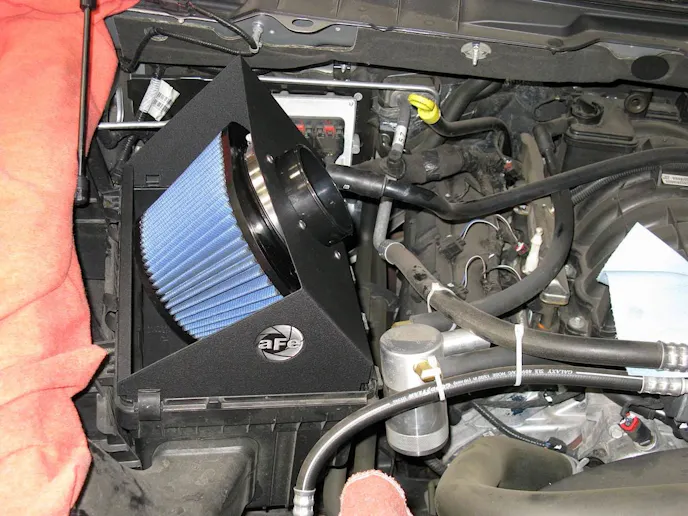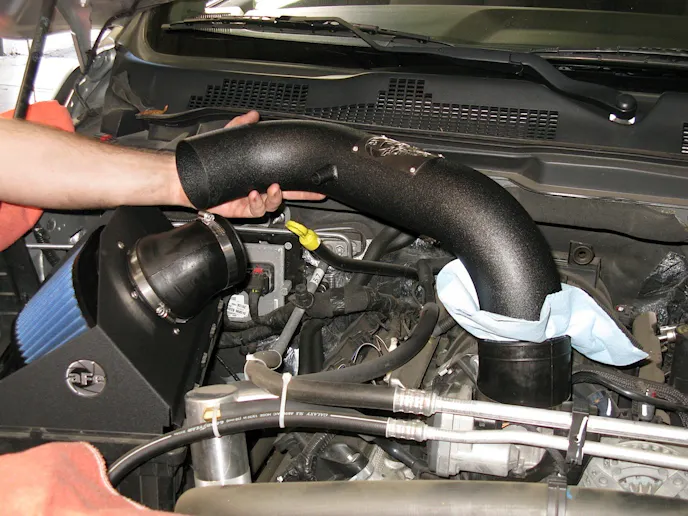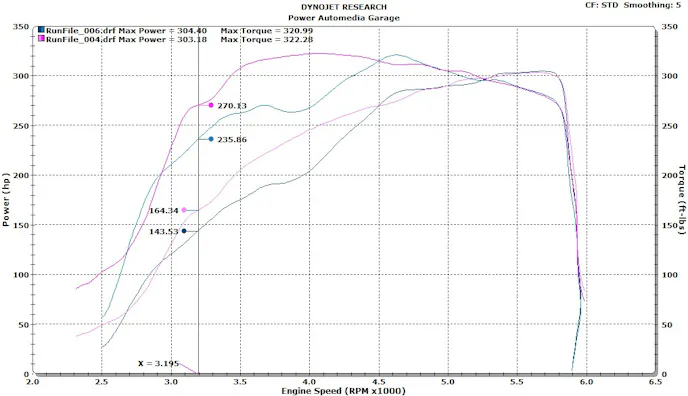Story By Dave Lukason
In the hunt for extra power from our trucks, everybody is looking for an edge. However, it’s often simply impossible to find large amounts of power gained from a small investment of time or cash. And honestly, we should all know better. There can be a way to get good clean power from a relatively minor investment in both time and money, and that is through the improved management of air flow into the engine. Replacement performance air intake systems are a perfect example.
aFe Stage 2 PRO 5R Parts List

- Pro 5R air filter
- Air filter adapter
- M6x10 button head bolts
- Intake tube
- Filter housing
- 36-inch rubber hose
- 29-1/4-inch trim seal
- 15 degree elbow coupling
- 40 degree elbow coupling
- Clamps and grommet
While the automotive manufacturers must deal with the restrictions placed upon them by the EPA and their own bean counters, this leads to a part of the engine that usually lacks from an all-out performance standpoint. The OEM intake system often does its job and nothing more. It’s no wonder that performance air intake systems have flourished in the automotive aftermarket.
How It Works
By doing a few things such as providing a better filter and straightening out, smoothing out and widening the path that air comes into the engine, you can increase the amount of air that is available for mixing with fuel. Better air flow can often mean more power. But how much power? At what RPM? How useable would the power be? We decided to find out.
In this specific installation we used the Magnum FORCE Stage-2 PRO 5R Intake system (Part Number 54-11632) from Advanced Flow Engineering, better known to most as aFe. The kit includes a massive 5-1/2-inch PRO 5R oval conical air filter that is a 5-layer progressive, oiled cotton gauze filter that allows for maximum flow to increase horsepower and torque.
“The advantage of this intake kit is the ease of installation, utilizing the lower half of the OE airbox,” said Saul Sambrano, aFe Power R&D Project Manager. A metal filter housing clips directly on top of the lower half of the factory air box. The kit also includes a powdercoated aluminum replacement intake tube designed to increase air flow after the air filter, improving performance and throttle response.
Our installation subject was a stock 2012 Ram 1500 with a 5.7L HEMI engine and six-speed automatic transmission. All testing was done on our in-house DynoJet dynamometer. We were interested in the mid-range, rather than peak horsepower/torque, as that’s where most driving is done, and where any difference will be largely felt.
Our recording target was 3,200 rpm (3,195), and stock output at this mark was 143.53 HP and 235.86 pound-feet of torque. The engine max’d out at 304.4 and 320.99, respectively, close to 5,800 RPM. We also took the truck to the track, and our best stock run on the 1/8th mile was 9.27 seconds at 75.73 MPH.
aFe includes everything with its systems so the DIY enthusiast is able to install the product in their driveway with minimal hand tools (5/16-inch nut driver, standard screwdriver, and 4 mm Allen wrench) and no modifications to the vehicle.
How It Goes Together
The advantage of this intake kit is the ease of installation … Saul Sombrano – aFe Power R&D Project Manager
Installation of the aFe air intake system was a breeze, and our shop mechanic had this finished within 30 minutes, even though he was stopping for us to take pictures of every step.
The fit and finish on the product was also exactly what we would expect from a company of aFe’s stature. Follow along below to see how easy this air intake system was to install and to find out what the resulting performance gains were.

Our first step of the installation was to remove the stock tubing and filter cover. The inlet air temperature sensor wire needed to be removed along with the EGR tube. Whenever working on an engine you want to be sure to cover any inlets that could allow anything to fall into the engine.
We then began the assembly of the aFe filter head unit. There is an adapter that bolts onto the metal box that mounts the filter.
Once assembled, this became one single piece that simply clipped into place using the factory filter housing clips.
The new aFe filter head unit mounts directly to the existing lower housing that held the OE filter. Saul Zambrano told us, “Our large oval filter offers a 22 percent increase in flow over the OE filter.” No tools were necessary for this step.
We then took the inlet air temperature sensor out of the factory intake and installed it into the new aFe aluminum tube with the supplied grommet. Then we attached the EGR hose to the engine and ran it into position to so we could hook it up to the new intake tube.
We did a test fit of the new aFe intake tube to get the clocking right for the silicone mounting couplers. Then we installed the intake tube and the EGR hose from the engine and tightened all of the hose clamps.
Last, but not least, we put the edge-guard material around the aFe head unit and checked all of the connections and fitment. It really is a very simple install. All in all, the aFe cold air intake is a great product that fits well and does what it was meant to do.
Proof Positive
What everyone wants to know is did the aFe air intake system make any power? As you can see in the dyno graph below comparing the before and after installation runs, there is an increase in horsepower and torque throughout the lower and middle section of the power curve.
The low- and mid-range is where the power is that you use and need most in a truck. Most of us expect that when a product makes more horsepower it takes an engine that makes 400 horsepower and raises that number to say 420 horsepower, (these are hypothetical numbers for discussion only). This is what we call peak horsepower, the point at which the engine makes the most power throughout the entire RPM range.

This is the number you see advertised in all manufacturer brochures and commercials, and is usually at a very high RPM (5,000+ or so). Now, how many of us drive our vehicles at this RPM on a normal basis?
Our large oval filter offers a 22 percent increase in flow over the OE filter. Saul Sambrano, aFe Power
Not many. What is more beneficial to the average driver is what we call the area “under the curve,” the RPM range you drive in during normal conditions, the 2,000 to 4,000 RPM range.
This RPM range is where you feel the “seat of the pants” difference when you are driving around town or accelerating away from the light. If you have a product that makes a little more horsepower at 5,200 RPM, how often are you really going to feel that?
However, add a product that delivers 20 or so more horsepower in the low- and mid-RPM range and you are going to feel that almost every time you step on the gas pedal. That is a product we feel is worth spending your hard-earned money on.
By looking at dyno graph below you can that the aFe intake system we installed on our subject vehicle stayed pretty close to the same horsepower at the peak RPMs as the stock intake, but the low- and mid-range had substantial gains–as much as 20 horsepower and 34 pound-feet of torque at our recording target, and this is in the RPM range where you drive the vehicle every day.
Feel The Power
Under heavy acceleration the aFe Magnum FORCE Stage-2 PRO 5R intake unit we installed on the 2012 Ram 5.7 V8 did make more noise than the stock intake. It was a throaty engine sound, however, that any car guy would enjoy and not something that kept us from appreciating the other benefits the aFe system had to offer.
The power increase was very noticeable in our driving test and really makes this truck feel like a lighter vehicle as it pulls away from a stop. During our post-installment track testing we saw a time of 9.17 seconds at 77.91 MPH. That’s a tenth of a second improvement and a gain of more than two miles per hour in speed on an 1/8-mile track, and that is a very good indicator the intake is doing its job of providing a less restrictive air path into the engine.
Not only did we gain power on the dyno and more speed at the drag strip, we also saw a good one-plus mile-per-gallon difference in our around-town fuel mileage. This is definitely appreciated with the high price of gasoline these days.
Overall, we finished the job with a satisfied feeling, knowing the simple installation of the aFe air intake system was a success and had delivered the goods–better fuel economy and more power.
You might also like
COBB Tuning Accessport Gains 45 Horsepower For Ford Bronco Raptor & Ranger Raptor
COBB Tuning launches Accessport ECU tuning for Ford Bronco Raptor and Ranger Raptor, unlocking more power, torque, and off-road performance.




